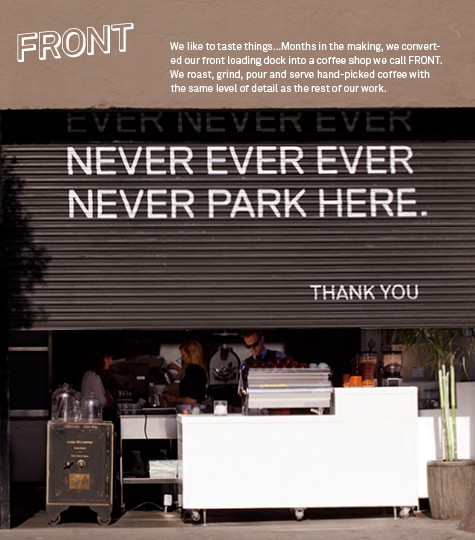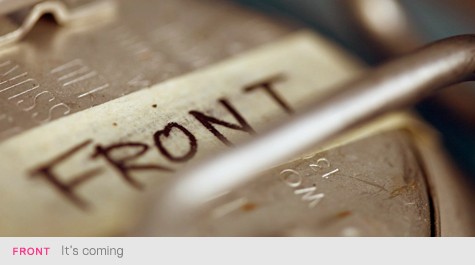by Hanna Neuschwander
Hanna Neuschwander is the author of Left Coast Roast, a guidebook to coffee roasters on the west coast. Her writing about coffee and food has appeared in publications including Travel + Leisure, Edible Seattle, Portland Monthly, the Oregonian, and Roast Magazine, among others. She has presented about coffee-related topics at events and conferences from San Francisco to Boston. She lives in Portland, Ore.
Front is a tiny new San Francisco microroastery in Portrero Hill that sits, well, at the front of a San Francisco start-up that has made good by bringing together eggheads from the worlds of design, film, robotics, and visual arts. Autofuss is a design/production company that uses repurposed auto manufacturing robots to shoot commercials for clients including Google, Jambox, Chevy, and Louis Vuitton. Like all hardworking, design-geeky entrepreneurs, the brains behind Autofuss wanted better-than-average coffee to keep the engines of industry turning. Rather than invite an existing coffee slinger into their space (like Amazon did with Victrola in Seattle, or like Facebook did with Philz Coffee in SF), the principles of Autofuss, Randall Stowell and Jeff Linnell, did one better and started their own microroastery. Now Front fronts the eclectic studios of Autofuss.

Photo courtesy of Autofuss
The teensy cafe has a few seats, but is mostly standing-room only, with Deutsche beer garden tables on the sidewalk. On nice days, a garage door rolls up to reveal the entire space. It’s built on the footprint of what used to be an industrial loading dock.
While Stowell and Linell are responsible for getting Front out of the harbor in 2012, the captain of the coffee ship is Ian McCarthy, who has been roasting for just over a year in the space. (The retail cafe opened in summer 2012). McCarthy first came to coffee when his grandparents threw him into the kitchen of their Italian-American restaurant at the ripe age of twelve. “My shift drink was either bad Italian-American restaurant espresso, or sparkling water with as many dashes of bitters as the barkeep would let me have,” he McCarthy. The year between high school and university, he had his God Shot moment: “I found an espresso that was better than any I had ever had at a cafe in Portsmouth, NH, called Black Bear. I wanted to be close to it. I demanded a job on the spot. A few months later, I was managing the cafe.” He went on to work at Metropolis in Chicago before relocating to the Bay Area.
Website: http://www.frontsf.com/
Visit: 150 Mississippi St., San Francisco. Open daily, 8am-4pm.
10 Questions
What inspires your roastery and your roasting?
The idea behind the coffee program at Front is to give gracious, honest hospitality while operating technically at the highest level possible. We sweat everything. This isn’t a large space, and we have a tiny roaster. The folks at Sterling, in Portland OR, (who started on a one-pound San Franciscan, operating out of a kiosk the size of a generous mop-closet), were big inspirations for me when I was presented the idea that was to become Front. They were as good a proof-of-concept as I was going to get, and they are killing it to this day.
Our roasting philosophy is to highlight the intrinsic qualities of the bean; the things that make it unique—variety, processing, geography. Terroir. In the end, this means having a light touch. I want our our coffees to be reflections of time and place, and have an energy like a tightly-coiled spring. To get technical, we roast our coffees for non-pressurized brewing in the city to city+ development stage range, usually for 10:30 to 11:20 minutes, dropping the coffee when the bean probe measures about 400-403F.
Single origins vs. blends: Which wins in a fight to the death?
The blends v. single origin question is an interesting one, and one I think roasters look at a little too narrowly. Why limit the question to political geography? I think we need to look at coffee through all possible lenses—processing, geography, varietal, etc.—to really have a complete picture of what we like or dislike about coffee. Do you love Kenyan coffee, or do you love SL-28? How many non-Kenyan SL-28 have you had? In particular, I am inspired by the work of an Alsatian winemaker, Marcel Deiss. Marcel grows the noble grapes of Alsace: riesling, gewurztraminer, pinot gris, and muscat. Normally, though not always, these grapes would be vinified separately, and you would simply buy a bottle of Pinot Gris from vineyard X. Marcel has a thought here, though—what if your conception of the vineyard in fact gets caught up in the variety? You think you are tasting vineyard X, but really you are tasting the qualities inherent in pinot gris in general. Now, you can of course drink lots and lots of pinot gris from Alsace and elsewhere and know what it is all about, which you should, but for Marcel it is more effective to see the vineyard from multiple angles simultaneously in order to see its full realized potential. He will vinify all of the grapes together and create a field blend. The idea is that when you eliminate the lens of varietal, you see the terroir for what it really is. If and when I blend coffees, its is with an approach inspired by this mentality—there has to be a concept behind the aesthetic. It has to give you some insight into one or more of our variables. Putting together a Bourbon from Rwanda with one from Brazil, roasting a single-origin espresso to three different roast levels, blending three different processing methods from a single estate—these are the sort of combinations that I think offer us insight into the breadth of variation and nuance inherent in coffee. Putting together an Indonesian coffee for earthiness, and a Costa Rican for brightness, so I can chase some idea of “balance,” this is less interesting to me. I am looking for the edge of things, less so the center.
We have a one-kilo Probat, and are moving up to a 15-kilo Loring Smart Roast shortly. I have more experience on Diedrich roaster, particularly the IR-12. From a R+D perspective, roasting on a one-kilo roaster is wonderful. From the perspective ofproduction, it is a nightmare.
Sustainability is something you think a lot about. Was that the rationale for deciding to buy a high-efficiency roaster like the Loring?

Photo courtesy of Autofuss
More than anything, I am realizing just how dirty and inefficient these pretty, old , German, fire-breathing beasts are. As lovely as an old Probat is from a roasting and aesthetic perspective, they are hardly sustainable. As much as my hair still stands on end when I tell people I am about to buy an air roaster, there is no way I can justify the footprint of either exhaust or afterburner anymore. Coffee Collective in Copenhagen is doing game-changing work using air roasters; this proves to me that new-fangled technology can be just as good if not better than the old roasters.
How did you get started roasting?
My roasting experience started in a tiny apartment in Chicago, using a hand-cranked popcorn popper, a stones throw away from Metropolis where I was working as a barista. Chris Schooley, the roaster and green buyer at the time, had an infectious dedication to roasting that ended up pulling more people than me into the craft. He was tremendously helpful, giving me spare green samples from importers, and letting me put my awful Whirly-Pop roasts on his cupping table.
Tell us about the most memorable coffee you’ve had.
There have been too many memorable cups to count. Like many people, I think it was probably a natural-processed Ethiopian coffee (fruit bomb!) that made me do my first double-take. Everything seemed possible after that.
Espresso or filter?
I am a big filter proponent. Occasionally, espresso preparation gives me the chance to see a facet of a coffee I would otherwise not experience. More often than not, I think non-pressurized brewing is the clearer lens through which to see a coffee. I drink much more coffee brewed with a Hario V-60 than anything else. I love the range of potential flavors possible with V-60s, almost as much as I love the range of opinions on how to use them.
What can I say about SF? I think there is as high a concentration of talent in this city as anywhere in the world. It is a flavor playground. It has me in its claws.
Preferred soundtrack for roasting?
Lots of jazz on the ones and twos. Sanders, Coltrane, Coleman, Sun Ra, Hamilton, Mingus. The same principles apply to roasting: Tension, dynamic range, and negative space. Sometimes too much is too much. Sometimes it is just enough.
Hanna Neuschwander
Hanna Neuschwander is director of communications for World Coffee Research. She has been communicating about coffee and science since 2004. Her writing has appeared in publications including Travel + Leisure, The Art of Eating, Portland Monthly, and Modern Farmer. Based in Portland, Oregon, she is the author of Left Coast Roast, a guidebook to artisan and influential coffee roasters on the West Coast.






Comment